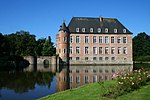
Ghent is a city and a municipality in the Flemish Region of Belgium. It is the capital and largest city of the province of East Flanders, and the third largest in the country, after Brussels and Antwerp. It is a port and university city.

Louis VI, called the Fat or the Fighter, was King of the Franks from 1108 to 1137. Like his father Philip I, Louis made a lasting contribution to centralizing the institutions of royal power. He spent much of his twenty-nine-year reign fighting either the "robber barons" who plagued the Ile de France or Henry I of England for his continental possession of Normandy. Nonetheless, Louis VI managed to reinforce his power considerably, often resorting to force to bring lawless knights to justice, and was the first member of the house of Capet to issue ordonnances applying to the whole of the kingdom of France.

Sint-Truiden is a city and municipality located in the province of Limburg, Flemish Region, Belgium, and has over 41,500 inhabitants, which makes it one of the largest cities in Limburg. The municipality includes the former communes of Aalst, Brustem, Duras, Engelmanshoven, Gelinden, Gorsem, Groot-Gelmen, Halmaal, Kerkom-bij-Sint-Truiden, Melveren, Metsteren, Ordingen, Runkelen, Velm, Wilderen, and Zepperen.

Assebroek is a sub-municipality of the city of Bruges located in the province of West Flanders, Flemish Region, Belgium. It was a separate municipality until 1971. On 1 January 1971, it was merged into Bruges. On 31 December 2014, Assebroek had 19,737 inhabitants. Since 1999, this number has hardly changed. Assebroek is home to 16.75% of Bruges’ population.
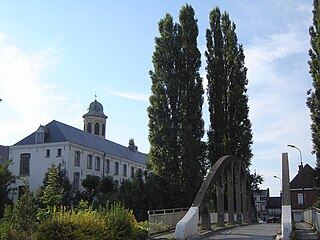
Drongen is a sub-municipality of the city of Ghent located in the province of East Flanders, Flemish Region, Belgium. It was a separate municipality until 1977. In 1967, part of the original municipality was already annexed to Ghent. On 1 January 1977, the municipality of Drongen was merged into Ghent.

Louis II, also known as Louis of Male, a member of the House of Dampierre, was Count of Flanders, Count of Nevers, and Count of Rethel from 1346 to 1384, and also Count of Artois and Count of Burgundy from 1382 until his death. He was the son of Count Louis I of Flanders and the Countess of Burgundy and Artois, Margaret I of Burgundy, the youngest daughter of the King of France, Philip V the Tall.

Male is a former hamlet and today a quarter in the east of Sint-Kruis, a sub-municipality of Bruges, West Flanders, Belgium. The hamlet, which retains its small historic center, clusters around Male Castle, best known as the birthplace of Louis, count of Flanders in 1329.

Bergues is a commune in the Nord department in northern France.

The Battle of Beverhoutsveld took place on 3 May 1382, on a field situated between the towns of Beernem, Oostkamp and Assebroek. It marked an important phase in the rebellion of Ghent against Louis II, Count of Flanders.
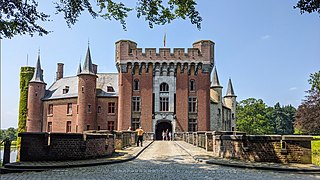
Wijnendale Castle is a historic residence in Wijnendale, West Flanders in Belgium which was once a medieval castle. The present buildings largely date to a nineteenth century restoration, though parts of the north wing still date to the fifteenth century. One wing is currently inhabited by the present owners of the castle, while another is open to the public as a museum.

Kortrijk, sometimes known in English as Courtrai or Courtray, is a Belgian city and municipality in the Flemish province of West Flanders.
St. Andrew's Abbey, Bruges was a Benedictine abbey in Sint-Andries, Bruges, Belgium, which was destroyed in the French Revolution. Its modern successor St. Andrew's Abbey, Zevenkerken, founded in 1899–1900, is a Benedictine abbey of the Congregation of the Annunciation.
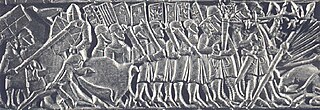
The Franco-Flemish War was a conflict between the Kingdom of France and the County of Flanders between 1297 and 1305.

Bruges is the capital and largest city of the province of West Flanders in the Flemish Region of Belgium, in the northwest of the country. It is the sixth most populous city in the country.

Ten Putte Abbey is a monastery with an abbey in Gistel, roughly 8 km to the south of Ostend, in the western part of Belgium. It was built to mark the spot where, in 1070, Saint Godelina was murdered by strangulation and then thrown into a pond. Before 2007 the abbey was home to nine Benedictine nuns, who were members of the wider Subiaco Cassinese Congregation in West Flanders. Since 2007 it has been occupied by brothers and sisters of the "Mother of Peace" community.

Eekhout Abbey was a medieval house of Augustinian Canons in Bruges, West Flanders, Belgium.
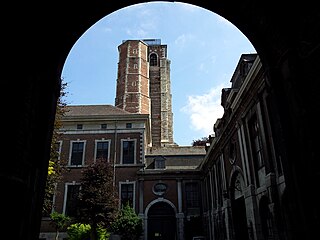
Sint-Truiden Abbey or St Trudo's Abbey is a former Benedictine monastery in Sint-Truiden in the province of Limburg, Belgium. The abbey was founded in the 7th century and was one of the oldest and most powerful in the Low Countries. The town of Sint-Truiden grew up around it. The great Romanesque abbey church, dedicated to Saint Remaclus and Saint Quintin, was demolished in 1798, four years after the suppression of the abbey.

Male Castle, Bruges. A community of the Canonesses Regular of the Holy Sepulchre. It originated in Bruges in the 11th century, and between 1954 and 2013 was settled in Male Castle in Male, Sint-Kruis, Bruges, West Flanders, Belgium.
The English expedition to Flanders (1297–1298) was an English expedition to Flanders that lasted from August 1297 until March 1298. King Edward I of England in an alliance with Guy, Count of Flanders, as part of the wider 1294–1303 Gascon War, led an English force to Flanders, hoping to form military alliances and support to lead a combined force against King Philip IV of France. The expedition was difficult and expensive for Edward, but enough of his allies went into action to gain a truce from the French. After a peace was reached with King Philip IV of France, Edward left Flanders in March 1298.
















